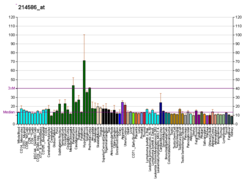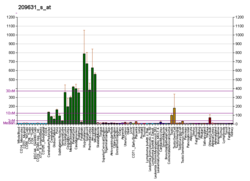| Revision as of 19:48, 28 October 2019 editBoghog (talk | contribs)Autopatrolled, Extended confirmed users, IP block exemptions, New page reviewers, Pending changes reviewers, Rollbackers, Template editors137,738 edits consistent citation formatting and removed further reading citation now included in-line← Previous edit |
Revision as of 01:36, 7 November 2019 edit undoHeadbomb (talk | contribs)Edit filter managers, Autopatrolled, Extended confirmed users, Page movers, File movers, New page reviewers, Pending changes reviewers, Rollbackers, Template editors454,149 edits Alter: journal. Add: year, pmc, pages, volume, bibcode. | You can use this tool yourself. Report bugs here. | via #UCB_GadgetNext edit → |
| Line 4: |
Line 4: |
|
== Interactions == |
|
== Interactions == |
|
|
|
|
|
GPR37 has been shown to ] with ]<ref name=pmid12150907>{{cite journal | vauthors = Imai Y, Soda M, Hatakeyama S, Akagi T, Hashikawa T, Nakayama KI, Takahashi R | title = CHIP is associated with Parkin, a gene responsible for familial Parkinson's disease, and enhances its ubiquitin ligase activity | journal = Mol. Cell | volume = 10 | issue = 1 | pages = 55–67 | date = July 2002 | pmid = 12150907 | doi = 10.1016/S1097-2765(02)00583-X }}</ref> and ].<ref name=pmid12150907/><ref name=pmid11439185>{{cite journal | vauthors = Imai Y, Soda M, Inoue H, Hattori N, Mizuno Y, Takahashi R | title = An unfolded putative transmembrane polypeptide, which can lead to endoplasmic reticulum stress, is a substrate of Parkin | journal = Cell | volume = 105 | issue = 7 | pages = 891–902 | date = June 2001 | pmid = 11439185 | doi = 10.1016/S0092-8674(01)00407-X }}</ref> |
|
GPR37 has been shown to ] with ]<ref name=pmid12150907>{{cite journal | vauthors = Imai Y, Soda M, Hatakeyama S, Akagi T, Hashikawa T, Nakayama KI, Takahashi R | title = CHIP is associated with Parkin, a gene responsible for familial Parkinson's disease, and enhances its ubiquitin ligase activity | journal = Molecular Cell| volume = 10 | issue = 1 | pages = 55–67 | date = July 2002 | pmid = 12150907 | doi = 10.1016/S1097-2765(02)00583-X }}</ref> and ].<ref name=pmid12150907/><ref name=pmid11439185>{{cite journal | vauthors = Imai Y, Soda M, Inoue H, Hattori N, Mizuno Y, Takahashi R | title = An unfolded putative transmembrane polypeptide, which can lead to endoplasmic reticulum stress, is a substrate of Parkin | journal = Cell | volume = 105 | issue = 7 | pages = 891–902 | date = June 2001 | pmid = 11439185 | doi = 10.1016/S0092-8674(01)00407-X }}</ref> |
|
GPR37 is a receptor for ]. It was previously thought to be a receptor for ], a ] found in the ], but early reports of head activator in mammals were never confirmed.<ref>{{cite journal |first1=Rebecca C.|last1=Meyer |first2=Michelle M.|last2=Giddens |first3=Stacy A.|last3=Schaefer |first4=Randy A.|last4=Hall |title=GPR37 and GPR37L1 are receptors for the neuroprotective and glioprotective factors prosaptide and prosaposin |date=4 June 2013 |journal=Proceedings of the National Academy of Sciences |volume=110 |issue=23 |pages=9529–34 |doi=10.1073/pnas.1219004110 |pmid=23690594 |pmc=3677493}} |
|
GPR37 is a receptor for ]. It was previously thought to be a receptor for ], a ] found in the ], but early reports of head activator in mammals were never confirmed.<ref>{{cite journal |first1=Rebecca C.|last1=Meyer |first2=Michelle M.|last2=Giddens |first3=Stacy A.|last3=Schaefer |first4=Randy A.|last4=Hall |title=GPR37 and GPR37L1 are receptors for the neuroprotective and glioprotective factors prosaptide and prosaposin |date=4 June 2013 |journal=Proceedings of the National Academy of Sciences |volume=110 |issue=23 |pages=9529–34 |doi=10.1073/pnas.1219004110 |pmid=23690594 |pmc=3677493|bibcode=2013PNAS..110.9529M }} |
|
</ref> |
|
</ref> |
|
|
|
|
|
GPR37 signaling has been shown to modulate the migration of ] (OECs) and ] (GnRH) cells in mice.<ref>{{cite journal | vauthors = Saadi H, Shan Y, Wray S | title = GPR37 Signaling Modulates Migration of Olfactory Ensheathing Cells and Gonadotropin Releasing Hormone Cells in Mice | journal = Front Cell Neurosci. | pmid = 31143101 | doi = 10.3389/fncel.2019.00200 }}</ref> |
|
GPR37 signaling has been shown to modulate the migration of ] (OECs) and ] (GnRH) cells in mice.<ref>{{cite journal | vauthors = Saadi H, Shan Y, Wray S | title = GPR37 Signaling Modulates Migration of Olfactory Ensheathing Cells and Gonadotropin Releasing Hormone Cells in Mice | journal = Frontiers in Cellular Neuroscience| volume = 13 | pages = 200 | pmid = 31143101 | pmc = 6521704 | doi = 10.3389/fncel.2019.00200 | year = 2019 }}</ref> |
|
|
|
|
|
== References == |
|
== References == |
| Line 15: |
Line 15: |
|
== Further reading == |
|
== Further reading == |
|
{{refbegin | 2}} |
|
{{refbegin | 2}} |
|
* {{cite journal | vauthors = Zeng Z, Su K, Kyaw H, Li Y | title = A novel endothelin receptor type-B-like gene enriched in the brain | journal = Biochem. Biophys. Res. Commun. | volume = 233 | issue = 2 | pages = 559–67 | year = 1997 | pmid = 9144577 | doi = 10.1006/bbrc.1997.6408 }} |
|
* {{cite journal | vauthors = Zeng Z, Su K, Kyaw H, Li Y | title = A novel endothelin receptor type-B-like gene enriched in the brain | journal = Biochemical and Biophysical Research Communications| volume = 233 | issue = 2 | pages = 559–67 | year = 1997 | pmid = 9144577 | doi = 10.1006/bbrc.1997.6408 }} |
|
* {{cite journal | vauthors = Donohue PJ, Shapira H, Mantey SA, Hampton LL, Jensen RT, Battey JF | title = A human gene encodes a putative G protein-coupled receptor highly expressed in the central nervous system | journal = Brain Res. Mol. Brain Res. | volume = 54 | issue = 1 | pages = 152–60 | year = 1998 | pmid = 9526070 | doi = 10.1016/S0169-328X(97)00336-7 | url = https://zenodo.org/record/1259931 }} |
|
* {{cite journal | vauthors = Donohue PJ, Shapira H, Mantey SA, Hampton LL, Jensen RT, Battey JF | title = A human gene encodes a putative G protein-coupled receptor highly expressed in the central nervous system | journal = Molecular Brain Research| volume = 54 | issue = 1 | pages = 152–60 | year = 1998 | pmid = 9526070 | doi = 10.1016/S0169-328X(97)00336-7 | url = https://zenodo.org/record/1259931 }} |
|
* {{cite journal | vauthors = Imai Y, Soda M, Inoue H, Hattori N, Mizuno Y, Takahashi R | title = An unfolded putative transmembrane polypeptide, which can lead to endoplasmic reticulum stress, is a substrate of Parkin | journal = Cell | volume = 105 | issue = 7 | pages = 891–902 | year = 2001 | pmid = 11439185 | doi = 10.1016/S0092-8674(01)00407-X }} |
|
* {{cite journal | vauthors = Imai Y, Soda M, Inoue H, Hattori N, Mizuno Y, Takahashi R | title = An unfolded putative transmembrane polypeptide, which can lead to endoplasmic reticulum stress, is a substrate of Parkin | journal = Cell | volume = 105 | issue = 7 | pages = 891–902 | year = 2001 | pmid = 11439185 | doi = 10.1016/S0092-8674(01)00407-X }} |
|
* {{cite journal | vauthors = Imai Y, Soda M, Hatakeyama S, Akagi T, Hashikawa T, Nakayama KI, Takahashi R | title = CHIP is associated with Parkin, a gene responsible for familial Parkinson's disease, and enhances its ubiquitin ligase activity | journal = Mol. Cell | volume = 10 | issue = 1 | pages = 55–67 | year = 2002 | pmid = 12150907 | doi = 10.1016/S1097-2765(02)00583-X }} |
|
* {{cite journal | vauthors = Imai Y, Soda M, Hatakeyama S, Akagi T, Hashikawa T, Nakayama KI, Takahashi R | title = CHIP is associated with Parkin, a gene responsible for familial Parkinson's disease, and enhances its ubiquitin ligase activity | journal = Molecular Cell| volume = 10 | issue = 1 | pages = 55–67 | year = 2002 | pmid = 12150907 | doi = 10.1016/S1097-2765(02)00583-X }} |
|
* {{cite journal | vauthors = Yang Y, Nishimura I, Imai Y, Takahashi R, Lu B | title = Parkin suppresses dopaminergic neuron-selective neurotoxicity induced by Pael-R in Drosophila | journal = Neuron | volume = 37 | issue = 6 | pages = 911–24 | year = 2003 | pmid = 12670421 | doi = 10.1016/S0896-6273(03)00143-0 }} |
|
* {{cite journal | vauthors = Yang Y, Nishimura I, Imai Y, Takahashi R, Lu B | title = Parkin suppresses dopaminergic neuron-selective neurotoxicity induced by Pael-R in Drosophila | journal = Neuron | volume = 37 | issue = 6 | pages = 911–24 | year = 2003 | pmid = 12670421 | doi = 10.1016/S0896-6273(03)00143-0 }} |
|
* {{cite journal | vauthors = Imai Y, Soda M, Murakami T, Shoji M, Abe K, Takahashi R | title = A product of the human gene adjacent to parkin is a component of Lewy bodies and suppresses Pael receptor-induced cell death | journal = J. Biol. Chem. | volume = 278 | issue = 51 | pages = 51901–10 | year = 2003 | pmid = 14532270 | doi = 10.1074/jbc.M309655200 }} |
|
* {{cite journal | vauthors = Imai Y, Soda M, Murakami T, Shoji M, Abe K, Takahashi R | title = A product of the human gene adjacent to parkin is a component of Lewy bodies and suppresses Pael receptor-induced cell death | journal = Journal of Biological Chemistry| volume = 278 | issue = 51 | pages = 51901–10 | year = 2003 | pmid = 14532270 | doi = 10.1074/jbc.M309655200 }} |
|
* {{cite journal | vauthors = Kubota K, Niinuma Y, Kaneko M, Okuma Y, Sugai M, Omura T, Uesugi M, Uehara T, Hosoi T, Nomura Y | title = Suppressive effects of 4-phenylbutyrate on the aggregation of Pael receptors and endoplasmic reticulum stress | journal = J. Neurochem. | volume = 97 | issue = 5 | pages = 1259–68 | year = 2006 | pmid = 16539653 | doi = 10.1111/j.1471-4159.2006.03782.x }} |
|
* {{cite journal | vauthors = Kubota K, Niinuma Y, Kaneko M, Okuma Y, Sugai M, Omura T, Uesugi M, Uehara T, Hosoi T, Nomura Y | title = Suppressive effects of 4-phenylbutyrate on the aggregation of Pael receptors and endoplasmic reticulum stress | journal = Journal of Neurochemistry| volume = 97 | issue = 5 | pages = 1259–68 | year = 2006 | pmid = 16539653 | doi = 10.1111/j.1471-4159.2006.03782.x }} |
|
* {{cite journal | vauthors = Omura T, Kaneko M, Okuma Y, Orba Y, Nagashima K, Takahashi R, Fujitani N, Matsumura S, Hata A, Kubota K, Murahashi K, Uehara T, Nomura Y | title = A ubiquitin ligase HRD1 promotes the degradation of Pael receptor, a substrate of Parkin | journal = J. Neurochem. | volume = 99 | issue = 6 | pages = 1456–69 | year = 2006 | pmid = 17059562 | doi = 10.1111/j.1471-4159.2006.04155.x | url = http://eprints.lib.hokudai.ac.jp/dspace/bitstream/2115/17141/1/JN99-6-2006.pdf | hdl = 2115/17141 }} |
|
* {{cite journal | vauthors = Omura T, Kaneko M, Okuma Y, Orba Y, Nagashima K, Takahashi R, Fujitani N, Matsumura S, Hata A, Kubota K, Murahashi K, Uehara T, Nomura Y | title = A ubiquitin ligase HRD1 promotes the degradation of Pael receptor, a substrate of Parkin | journal = Journal of Neurochemistry| volume = 99 | issue = 6 | pages = 1456–69 | year = 2006 | pmid = 17059562 | doi = 10.1111/j.1471-4159.2006.04155.x | url = http://eprints.lib.hokudai.ac.jp/dspace/bitstream/2115/17141/1/JN99-6-2006.pdf | hdl = 2115/17141 }} |
|
{{refend}} |
|
{{refend}} |
|
|
|
|





